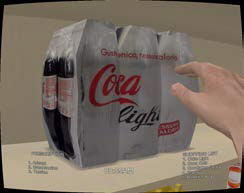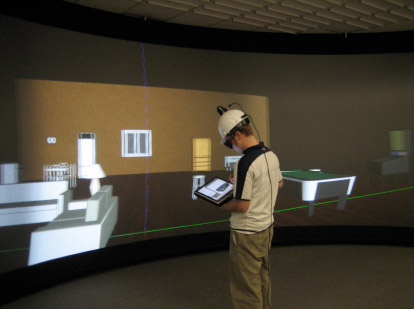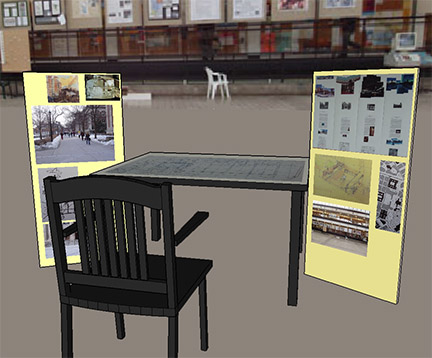Applications of Immersive Virtual Environments Technology
Virtual environments technology has the potential to enable fundamental and transformative advances in a variety of disciplines, from architectural design and visualization to neuropsychology and rehabilitation, by enabling people to actively engage in interactive virtual experiences that can evoke a functional understanding equivalent to what could be achieved in the real world. Over the past ten years, my group has worked in close collaboration with faculty in the Department of Architecture to develop VR technology that has the potential to enhance the creativity of the conceptual design process and facilitate an accurate, experiential understanding of designed spaces before they are built. We have also enjoyed diverse collaborations involving other applications of virtual reality in areas such as neuropsychology and the study of visual perception.

|
Enhancing Neurocognitive Assessment Using Immersive Virtual Reality, Thomas D. Parsons, Susan McPherson and Victoria Interrante (2013) IEEE Virtual Reality Workshop in Virtual and Augmented Assistive Technology, pp. 27-34.
[PDF]
[abstract]
|
Immersive virtual reality has significant potential as a tool for enhancing the reliability and specificity of neurocognitive assessment by supporting the ability to carry out carefully controlled, replicable, highly detailed and ecologically valid testing of peoplesŐ ability to perform complex executive functions such as planning and organizing, problem-solving and multitasking, and selective attention and inhibitory control, which are difficult to evaluate using standard paper-and-pencil measures of basic cognitive abilities such as memory, learning, or reasoning. We begin this short paper with an overview of current diagnostic needs in the field of neuropsychology, and a vision of the advantages that immersive virtual reality has the potential to offer as a diagnostic platform. We then briefly summarize our preliminary efforts to develop a robust virtual reality platform for neuropsychological assessment that incorporates a variety of physiological metrics as well as detailed measures of multiple attributes of task performance in a Virtual Environments Grocery Store (VEGS).

|
A Tablet Based Immersive Architectural Design Tool, Ross Tredinick, Lee Anderson, Brian Ries, Victoria Interrante and D'nardo Colucci (2006) Synthetic Landscapes [Proceedings of the 25th Annual Conference of the Association for Computer-Aided Design in Architecture], pp. 328-340.
[PDF]
[abstract]
|
In this paper we describe a SketchUp VR system in which we create a hybrid two-dimensional / three-dimensional immersive architectural design system. This system combines a tablet PC, an optically tracked room, a display wall, a SpaceTraveler motion controller, and stereographic eyewear to allow immersive conceptual design and walkthrough using a version of SketchUp that has been enhanced with Ruby plug-ins. The tablet PC provides a "sketchpad" type of user interface for SketchUp, while the tracked space and display wall enable the designer simultaneously to design at full (or any other) scale in an immersive (VR) environment.

|
A Virtual Environment for Conceptual Design in Architecture, Lee Anderson, James Esser and Victoria Interrante (2003) 9th Eurographics Workshop on Virtual Environments/7th International Workshop on Immersive Projection Technology, pp. 57-63.
[PDF]
[abstract]
|
We present a virtual environment application that has been developed for conceptual design in architecture and seeks to emulate aspects of a typical designer's work area. The environment provides a means of creating and manipulating basic geometry using a kiosk toolbox. More importantly, the environment provides simple means for using imagery and videos developed outside of the environment for use within the environment for both information and design. A DesignStation is provided within the environment to create a work area for the designer, concentrating imagery and information associated with the design as well as an area for reflecting upon, presenting and critiquing the design process. A unique aspect of the environment is the ability to work in more than one scale simultaneously.



